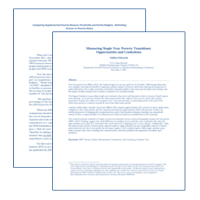Measuring the Presence and Impact of Same-Sex Married
Measuring the Presence and Impact of Same-Sex Married
Introduction
Since 2010, the Current Population Survey Annual Social and Economic Supplement has treated respondents who report being in a same-sex married couple as unmarried partners. This has implications for poverty measurement as the official poverty measure assumes that resources are shared only across family units and unmarried partners are not categorized as “families” in the official poverty measure. Currently, income from each member of a same-sex married couple is compared separately to his/her own poverty threshold.
Beginning in the 2018 CPS ASEC, the U.S Census Bureau expects to implement new editing procedures—coding same-sex married couples as a single family consistent with their survey responses. In order to evaluate this change on official estimates of the national poverty rate, this paper uses data from calendar years 2014 and 2015 to examine the presence and characteristics of same-sex married couples and evaluate how estimates of poverty are impacted by treating same-sex married couples as separate or combined families.
Findings indicate that current data processing rules lead to higher poverty estimates among individuals in same-sex marriages, as well as for related family members in these households. When same-sex married couples are assigned to family units consistent with those in opposite-sex marriages, poverty rates for the married population do not vary statistically based on relationship type. The impact of these family assignment changes on overall poverty rates is limited, with national estimates consistent to the nearest tenth of a percentage point.





